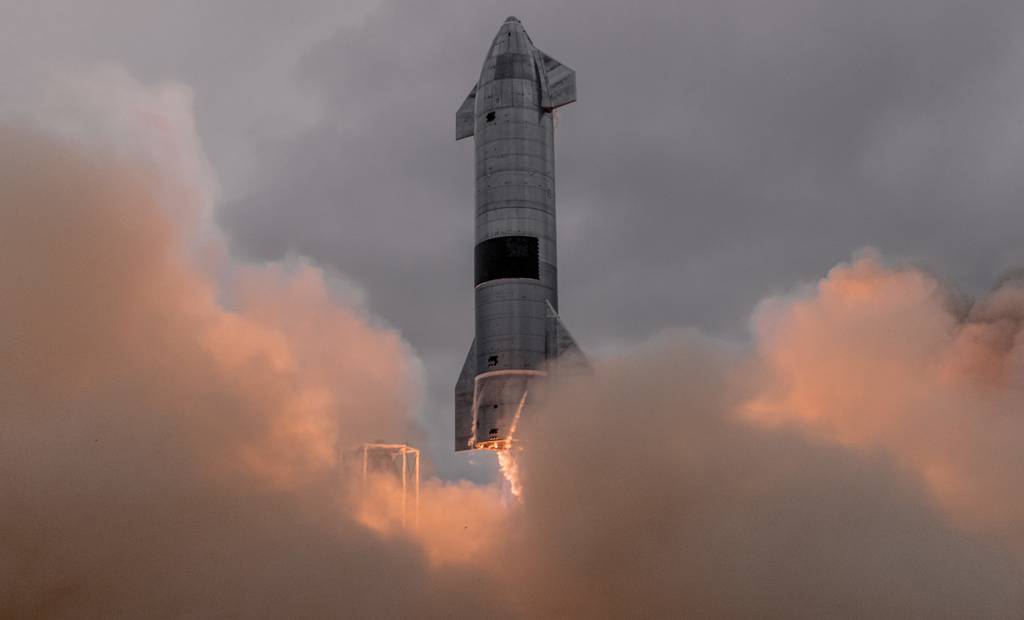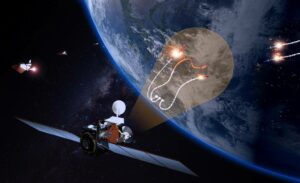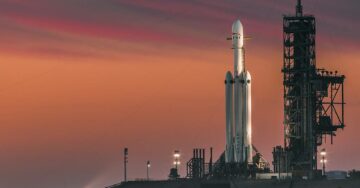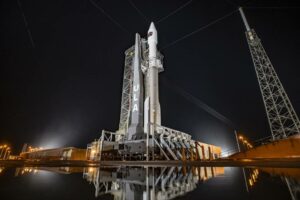
WASHINGTON — The U.S. Department of the Air Force’s effort to one day launch equipment halfway around the world via space-bound rockets will go through a series of test flights in 2024 that could reveal whether the concept would even work.
And in about three years, the department should have enough data to make a decision on whether to operationalize Rocket Cargo or move onto something else, according to Greg Spanjers, the chief scientist of the Air Force Research Laboratory’s Integrated Capabilities Directorate at Wright-Patterson Air Force Base in Ohio.
Rocket Cargo is one of the lab’s so-called Vanguard programs, which aim to use cutting-edge technology to develop and deliver new capabilities troops can use on the battlefield. This program is studying the commercial rocket sector to see if the military could rapidly transport goods around the world, though the program does not itself fund the development of commercial rockets.
In 2022, the lab awarded a five-year, $102 million contract to SpaceX so the former could collect flight data from the latter’s Starship rocket program.
The effort hasn’t always gone smoothly.
In April, one of SpaceX’s Starship rockets exploded shortly after takeoff. While Spanjers said he didn’t consider the launch a failure, as it met the company’s goal of clearing the launch pad, the explosion happened too soon to collect usable data.
Spanjers, who manages Rocket Cargo for the Air Force, told Defense News in an Nov. 1 interview he hopes more test flights that could yield data will come soon.
SpaceX on Nov. 18 carried out a second test launch of a Starship rocket, but it exploded shortly after the stage separation phase. AFRL did not respond by press time to a query about how much data was collected before this rocket’s explosion.
Hopes and plans
Spanjers envisions the Rocket Cargo program one day carrying out one launch per day, on each launch pad, with about an hour’s notice, and be able to carry 100 tons of cargo in a single rocket, as needed. But even this full capacity wouldn’t be enough to replace traditional air logistics or maritime shipping, he added, though it could provide an avenue for quickly transporting high-end cargo on relatively short notice.
By the end of 2024, he explained, the program wants enough flight data from Starship rockets going into orbit.
Next year, he said, the Air Force also plans to have a cargo bay mockup — basically the upper half of a Starship — it can use to refine the techniques for rapidly loading and unloading 20-foot containers from a rocket. That mockup is now in the final stages of construction by the engineering firm SES in Alliance, Ohio.
And by 2026 — though Spanjers said it could be done by 2025 — the Air Force expects the Rocket Cargo program to demonstrate the ability to rapidly launch rockets, bring large masses of cargo down from orbit, and rapidly load and unload cargo.
As one of SpaceX’s first customers for its Starship rocket program, the Air Force is helping the company figure out what matters most to the Defense Department, Spanjers said, such as the ability to turn a rocket around quickly for repeated flights.
But the cargo capacity the Air Force has in mind would put a great deal of stress on the rockets’ thermal protection systems, actuators and other components, he explained, and it’s important for rocket producers like SpaceX to keep those needs in mind as they design rockets.
Pressure mounts
Perhaps the most important piece of data the Air Force Research Laboratory wants to collect is information on how fast pressure drops when a rocket reaches space, and then the change in pressure when it reenters the atmosphere, Spanjers said. This will help the service learn how cargo might respond in the vacuum of space, and thus how to protect it.
“If our cargo hits [a] hard vacuum, that’s a real problem because we don’t want to make cargo that is specially designed to survive rocket transport,” he said. “This rocket is big enough we could put Humvees in it. [But] if you take a vehicle and put it in a hard vacuum, all of the greases, the oils, the fuels — they’re just going to vaporize instantly.”
The lab is considering a few options regarding which sections of the rocket to pressurize and by how much, Spanjers said.
A container-testing process is under consideration to take place in large Air Force and NASA vacuum chambers by late 2024. Spanjers said the testing would likely start with small containers and then involve larger ones as SpaceX advances its own rocket development. He noted the Air Force plans to collect data on every Starship launch using both external and internal sensors.
“We have a great opportunity here to test right along with them,” he said. “We’ll get a lot of testing at a very good cost for the taxpayer.”
The Air Force also wants to collect “vibe and shock” information that tracks how much turbulence the cargo on board a rocket must withstand during launch. But Spanjers doesn’t expect vibrations to present a major problem. After all, he said, the Air Force regularly throws pallets of cargo out of the back of massive transport planes.
And as rockets get larger, he added, “the ride gets gentler.”
Still, he noted, the lab’s engineers need vibration data to ensure the containers — which five companies are working to create — will be able to carry military cargo and survive a space launch. The Rocket Cargo program also needs to show whether people can rapidly unload cargo from these containers in order to reuse them for the next launch, he said.
The lab also wants more data on how rockets’ thermal protection systems work and how much mass can be safely brought down from orbit. More weight means more drag force, Spanjers explained, which then creates a significant amount of heat that must somehow dissipate.
“The amount of weight that SpaceX is seeking to bring down from space is well beyond anything we did on [the] Space Shuttle” program, Spanjers said. “I think it’s about a factor of five higher than anything we’ve ever brought down from orbit before.”
Spanjers said the U.S. rocket sector has recently made several advancements that hint at the feasibility of the Rocket Cargo concept. For decades, he noted, the country carried out three or four rocket launches per year. But by last year, he said, that swelled to 100 launches — mostly carried out by SpaceX — and next year it could top 150, about one every other day.
And twice in the last few months, Spanjers said, SpaceX has been able to reuse a launch pad two and a half days after a rocket took off from there.
In addition, Space Systems Command in September carried out a rocket launch from Vandenberg Space Force Base in California 27 hours after receiving launch orders. This marked a record for tactically responsive space launch.
“If you go back a year or two, it took somewhere between four months and four years to launch a rocket,” Spanjers said. “These are pretty significant achievements we’re making in creating launch operations that look a lot more like airplane operations.”
Spanjers added that the Air Force lab plans to go through several rounds of “build, break, build, break” experimentation until it finds a design that works.
“These [science and technology] challenges that we’re talking about here, these are not trivial,” he said. “Nobody’s ever tried to put a Humvee on a rocket before.”
Stephen Losey is the air warfare reporter for Defense News. He previously covered leadership and personnel issues at Air Force Times, and the Pentagon, special operations and air warfare at Military.com. He has traveled to the Middle East to cover U.S. Air Force operations.
- SEO Powered Content & PR Distribution. Get Amplified Today.
- PlatoData.Network Vertical Generative Ai. Empower Yourself. Access Here.
- PlatoAiStream. Web3 Intelligence. Knowledge Amplified. Access Here.
- PlatoESG. Carbon, CleanTech, Energy, Environment, Solar, Waste Management. Access Here.
- PlatoHealth. Biotech and Clinical Trials Intelligence. Access Here.
- Source: https://www.defensenews.com/battlefield-tech/space/2023/12/04/will-rocket-cargo-work-data-collected-in-2024-may-hold-the-answer/
- :has
- :is
- :not
- 1
- 10
- 100
- 150
- 2022
- 2024
- 2025
- 2026
- 27
- 70
- a
- ability
- Able
- About
- According
- achievements
- added
- addition
- advancements
- advances
- AFRL
- After
- aim
- AIR
- Air Force
- Air Force Research Laboratory
- Airplane
- All
- Alliance
- along
- also
- always
- amount
- an
- and
- answer
- anything
- April
- ARE
- around
- AS
- At
- Atmosphere
- Avenue
- awarded
- back
- base
- Basically
- Battlefield
- Bay
- BE
- because
- been
- before
- between
- Beyond
- Big
- board
- both
- Break
- bring
- brought
- build
- but
- by
- california
- CAN
- capabilities
- Capacity
- Cargo
- carried
- carry
- carrying
- challenges
- change
- chief
- Christmas
- Clearing
- collect
- COM
- come
- commercial
- Companies
- company
- Company’s
- components
- concept
- Consider
- consideration
- considering
- construction
- Containers
- contract
- Cost
- could
- country
- cover
- covered
- create
- creates
- Creating
- Customers
- cutting-edge
- data
- day
- Days
- deal
- dec
- decades
- decision
- Defense
- Defense Department
- deliver
- demonstrate
- Department
- Design
- designed
- develop
- Development
- DID
- does
- Doesn’t
- done
- Dont
- down
- Drop
- dropped
- Drops
- during
- each
- East
- effort
- else
- end
- Engineering
- Engineers
- enough
- ensure
- envisions
- equipment
- Even
- EVER
- Every
- expect
- expects
- explained
- explosion
- external
- factor
- Failure
- FAST
- feasibility
- few
- Figure
- final
- final stages
- finds
- Firm
- First
- five
- flight
- Flights
- For
- Force
- Former
- four
- from
- fuels
- full
- fund
- get
- Go
- goal
- going
- gone
- good
- goods
- great
- Half
- halfway
- happened
- Hard
- Have
- he
- help
- helping
- here
- High-End
- higher
- Hits
- hold
- hopes
- HOURS
- How
- How To
- HTTPS
- if
- images
- important
- in
- information
- instantly
- integrated
- internal
- Interview
- into
- involve
- issues
- IT
- ITS
- itself
- jpg
- just
- Keep
- lab
- laboratory
- large
- larger
- Last
- Last Year
- Late
- launch
- launches
- Leadership
- LEARN
- like
- likely
- load
- loading
- logistics
- Look
- Lot
- made
- major
- make
- Making
- manages
- Maritime
- marked
- Mass
- masses
- massive
- Matters
- May..
- means
- met
- Middle
- Middle East
- might
- Military
- million
- mind
- months
- more
- most
- mostly
- move
- much
- must
- Nasa
- Need
- needed
- needs
- New
- news
- next
- noted
- Notice..
- nov
- now
- of
- off
- Ohio
- oils
- on
- ONE
- ones
- open
- operation
- Operations
- Opportunity
- Options
- or
- Orbit
- order
- orders
- Other
- our
- out
- own
- pad
- pentagon
- People
- per
- Personnel
- phase
- piece
- Place
- Planes
- plans
- plato
- Plato Data Intelligence
- PlatoData
- present
- press
- pressure
- pretty
- previously
- Problem
- process
- Producers
- Program
- Programs
- protect
- protection
- provide
- put
- quickly
- rapidly
- Reaches
- real
- receiving
- recently
- record
- refine
- regarding
- regularly
- relatively
- repeated
- replace
- reporter
- research
- Respond
- responsive
- reuse
- reveal
- Ride
- right
- rocket
- rounds
- s
- safely
- Said
- Science
- Science and Technology
- Scientist
- Second
- sections
- sector
- see
- seeking
- sensors
- September
- Series
- service
- several
- Shipping
- Short
- Shortly
- should
- show
- significant
- single
- small
- smoothly
- So
- somehow
- something
- somewhere
- Soon
- Space
- Space Force
- SpaceX
- special
- specially
- Staff
- Stage
- stages
- starship
- start
- stress
- Studying
- such
- supply
- survive
- Systems
- Take
- talking
- Taxpayer
- techniques
- Technology
- test
- Testing
- than
- that
- The
- the world
- Them
- then
- There.
- thermal
- These
- they
- think
- this
- those
- though?
- three
- Through
- Thus
- time
- times
- to
- told
- tons
- too
- took
- top
- traditional
- transport
- transporting
- traveled
- tried
- turbulence
- TURN
- Twice
- two
- u.s.
- U.S. Air Force
- under
- until
- usable
- use
- using
- Vacuum
- Vanguard
- vehicle
- very
- via
- want
- wants
- was
- Watch
- we
- weight
- WELL
- What
- when
- whether
- which
- while
- WHO
- will
- with
- Work
- working
- works
- world
- would
- year
- years
- Yield
- you
- zephyrnet












